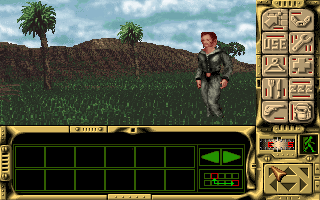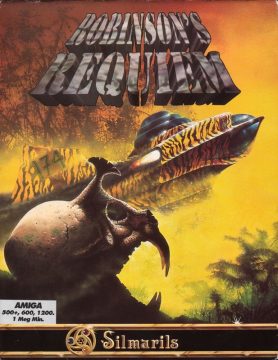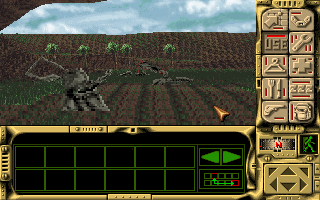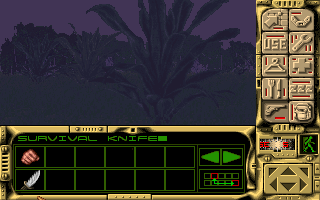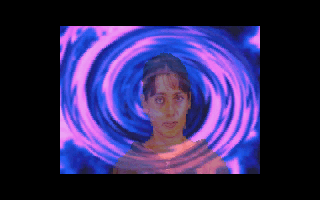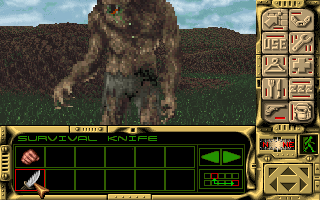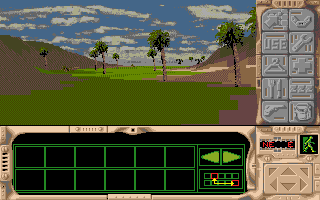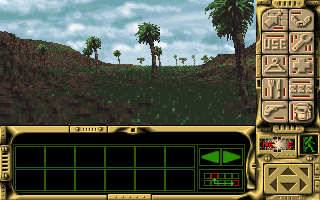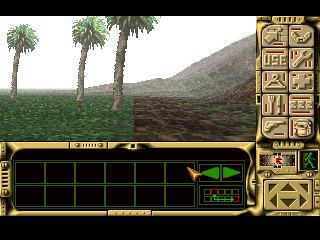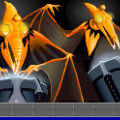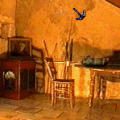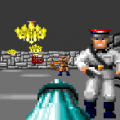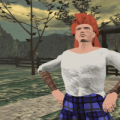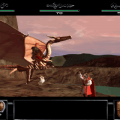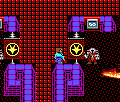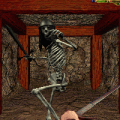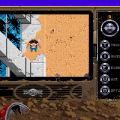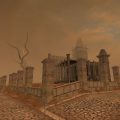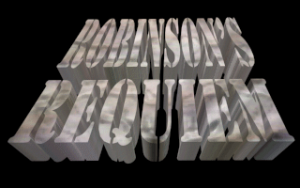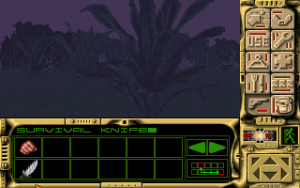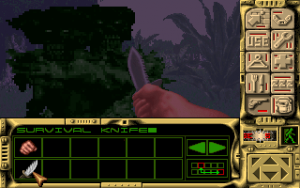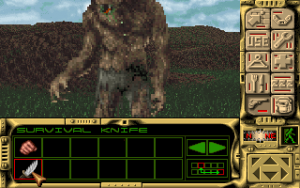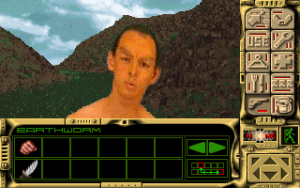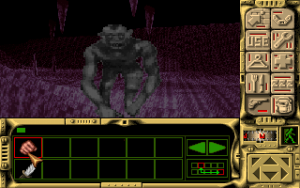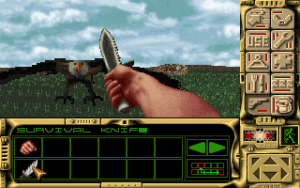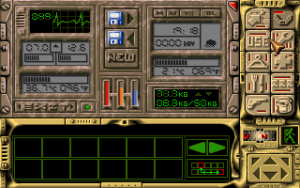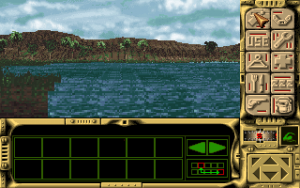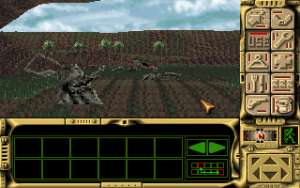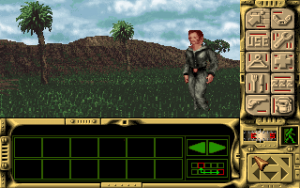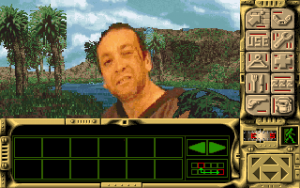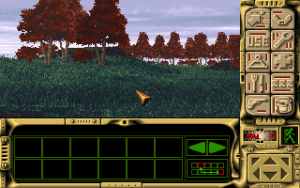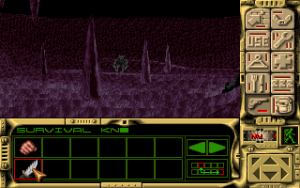Robinson’s Requiem is a sci-fi adaptation of the classic novel Robinson Crusoe, as you control someone stranded on a hostile territory. But instead of the protagonist being a regular guy stuck on a deserted tropical island, you’re an excommunicated member of the Robinson space exploration team, codenamed Trepliev1, exiled to the planet of Zarathustra. Your goal is to survive and escape, which is naturally much easier said than done.
At the time of release in 1994, Robinson’s Requiem didn’t really fit into a standard genre, being something like a first-person adventure/RPG hybrid, but nowadays it’s what we would term a survival simulation. While the Ishar series from developer Silmarils use the standard grid-based movement seen in many other first-person RPGs of the 1980s and early 1990s, Robinson’s Requiem features fully 3D movement. Much of the time is spent wandering the open world, but simply exploring and finding everything you need to succeed isn’t enough, because you have to deal with the effects of the environment as well as your own fragile body. Get attacked by an enemy and the wound may become infected. Fall too far and you’ll break a limb or two. Swim for too long and you’ll catch the flu. Forget to eat and you’ll starve to death. The number of ways you can die include, but are not limited to: alcoholic overdose, dehydration, asphyxiation, electrocution, hypertension, exhaustion, hypothermia, poisoning, blood hemorrhaging, heart attack, cold water shock, and plain old violent trauma.
So, you need to be vigilant in not only avoiding these conditions but also treating them when they almost inevitably happen. A mild flu will just cause some regular sneezing, which is nothing to worry about. You can avoid temperature fluctuations or bad weather by sleeping in caves along with a campfire. But infections can become gangrenous, and a limb might need to be amputated to save your life. Granted, severed limbs obviously don’t grow back, and if ever get to that point, you’re probably better off reloading an earlier save game, but the fact that game even allows such a thing to be possible is what makes the game so impressive in its detail. Elements like this were later made more accessible in Metal Gear Solid 3, released over a decade later for the PlayStation 2, though these elements were a relatively small part of the experience instead of one of the main gameplay elements.
What makes it so difficult is how little of it is explained, and how it expects you to learn by trial and error. The game tosses a lot of information at you, particularly in your personal computer, which may show you things like vital stats but fails to label them. Much of the time, you may not realize that you’re doing anything dangerous until an on screen scrolling message calmly tells you that you’ve perished along with your cause of death.
Even once you’ve got a grasp on the game’s rules, progression is rarely clear for numerous reasons. The automap will occasionally point you to other stranded humans, but otherwise your only guidance comes in the form of telepathic messages from Nina1, another stranded Robinson who will visit you in your sleep. Sometimes she gives you hints and other forms of guidance, sometimes she merely berates you. She’s not exactly the most stable or welcoming of partners, but she’s the closest you’ve got.
So much of the time you just need to figure things out. One of the first things you need to do is leave the starting jungle. But doing so requires passing through caves, which are shrouded in complete darkness. The game expects that you’ve thoroughly searched your crashed spaceship to find your medicine kit, along with a pair of matches. You’re also supposed to track down and murder one of the other hostile Robinsons in the area, stealing his knife. Then, you’re supposed to cut branches off trees, and find a very specific tree that has resin, which you can use to cobble together a torch. Many important items aren’t found but rather crafted like this, like creating new clothes from the skins of hunted animals, or bows and fishing rods from branches and other plants.
What makes this difficult is how cluttered the game is, making it hard to discern important items from the clutter. Players need to be particularly astute in order to find the medical kit among your ship’s wreckage, and it’s the most important item in the game!
It doesn’t help that even basic navigation can be cumbersome. Your character evidently can’t climb much of anything more than knee height, because you’ll regularly get caught on hilly terrain, and the only way to escape is to try to wiggle out. The interface tries its best, with various commands and several inventory screens, but that also means you’ll often fumble to enter combat mode when something approaches you.
Despite the game’s overt hostility, once you learn its rules – either by repeated deaths or restarts, or perhaps more easily, from reading a guide – Robinson’s Requiem isn’t quite as intimidating as it initially appears. Just learn how to get food and where to get water, and learn where to find appropriate places to sleep, and that’s a good starting point. And the medical kit you find at the beginning has the basic medical supplies you need, so as long as you aren’t neglectful of your conditions after combat, then you’ll probably be okay, for the most part. It’ll still require that you keep some save games handy in case things get too messed up, though. The game world isn’t as big as it first seems either, with five main areas linked by a handful of caves. Players who know what they’re doing can beat the game in less than five hours. Even if you aren’t set on completing it, just see how far you can get before you die – the emergent scenarios that come from the game’s environmental and medical complexities make for their own sordid joy.
Robinson’s Requiem has different 3D rendering techniques depending on the platform. The Amiga, Atari Falcon, and Atari ST versions use simple dithered polygons and other flat surfaces, making it the weakest looking of all of the release. The DOS version uses a voxel engine, which is an improvement but adds to the visual cacophony that can make it hard to make out important items. The 3DO version features 3D texture mapped terrain, but the draw distance is extremely limited due to the large amounts of fog. The interface is poorly adapted for a controller too, requiring that you hold down a button to use the arrow for any of the main functions. This version also gives you a full map instead of requiring that you map out the land yourself. A Jaguar CD version was developed but cancelled before official release; it was eventually completed in 2011 and released by fans, being pretty close to the 3DO version but with a worse framerate. All versions use sprites for the characters. The DOS and 3DO versions are on CD, which includes FMV and voice acting for the introduction and all NPC interactions. Being a translation from a French game, both the translation and the English voice acting feels goofy and awkward, particularly the messages from Nina1. But it all comes together to add to the surreal vibes of this dangerous alien world.
A few years later a follow-up called Deus was released for DOS, which follows the further adventures of Trepliev1 after he escapes. It features similar survival systems, though an “action” mode lets you disable them if you’d rather not be bothered. It also features enhanced 3D graphics, with smoother, full screen visuals and exchanging the sprite-based characters for polygons.
